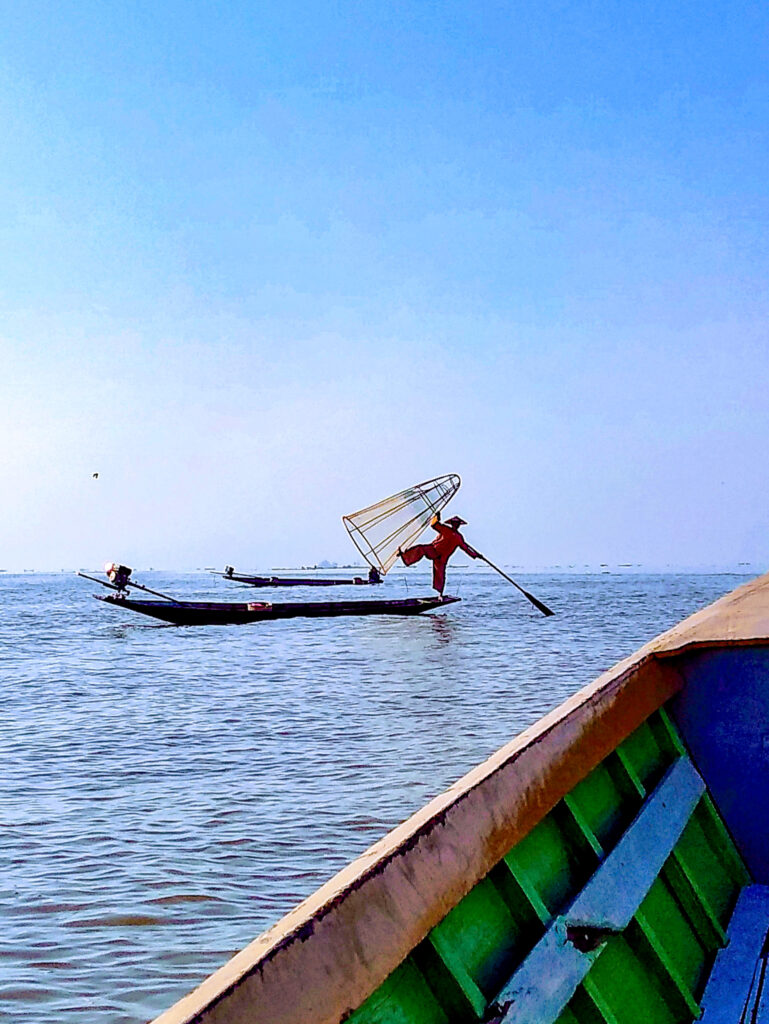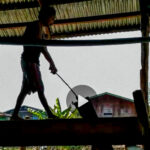“Leg-Rowing Fishermen, the Icons of Inle Lake”.

See photos
Where is Inle Lake?
Inle Lake is a freshwater lake located in the Nyaungshwe Township of Taunggyi District in Shan State. The lake is a major tourist attraction.
Houses in the village on the lake sit on stilts and are made of woven bamboo. Attractions that are found in the village include. Traditional silversmithing, silk weaving, cheroot manufacture, and handmade carvings and ornaments.


A local floating market is held daily on the lake. The location changes daily to one of five sites around the lake area. Each site hosts the market every fifth day.
Getting there
Our journey from Bagan to Inle Lake was by bus.
Our accommodation
During our time in Inle Lake, we chose to stay at the Thousand Island Hotel, booked through Booking.com. The hotel is located on the river in Nyaung Shwe, which links to Inle Lake.

Spacious rooms with a large ensuite bathroom, containing a separate bath and shower. Our room had a small terrace overlooking the river, air-conditioning, a flat-screen satellite TV, a minibar, a safety deposit box, an iron and ironing board, and tea/coffee making facilities. Slippers and bathrobes were also provided.
There are a rooftop bar and a restaurant. Breakfast was quite basic but acceptable.
Restaurants
Paw Paw Restaurant
A self-funded family run home kitchen restaurant and community development project. Not only does Zi Zi, the owner, run a fantastic little restaurant. She also contributes to local community development. Supporting women in need and providing education programs to young people from remote villages.
Her bamboo house restaurant is clean and cozy. Providing freshly cooked homemade family recipes from locally sourced ingredients. We enjoyed both the food and the atmosphere so much the first night, we went back again on our second night.
Pancake Kingdom
Great food and lovely service. This place is definitely worth a visit when in Nyaungshwe! The Crepes are great, savory, or sweet ones. Milkshakes delicious and pancakes to die for. Cozy place with a homely vibe
Places of interest
Nyaung Shwe is the tourist hub for anyone visiting Inle Lake. It consists of one main road with a number of side streets off it. The main road has shops, restaurants, stupas, travel agencies, and a market.
At the end of the road there is a bridge crossing over the river, turn left immediately before the bridge and you will see longboats for Inle Lake day trips moored up. The town serves as the marina for the many traditional longboats which take tourists onto the lake, a couple of miles away.

Day trip on Inle Lake
Approached by a number of locals all trying to sell us their boat trip around the lake. In the end, we decided to hire our own boat, with a driver. The whole day costing 25000 Kyat and taken where we wanted to go.
Fortunately for us, the meeting point for our longboat trip was right outside our hotel. Our boat driver Tin Win met us at 0800 hrs. He took us to his very comfortable traditional longboat, with cushioned timber garden chairs for us to sit on.
The boats are fitted with a single-cylinder inboard diesel engine and have been designed to cope with the shallow channels within the lake. The propeller is on a flexible drive, so it can be easily raised allowing maximum propulsion. With only half of the propeller in the water, this creates some magnificent rooster tail plumes behind the boats as they glide across the water.

A few cranks of the handle, the beast fired up and we were on our way down the channel towards the lake, creating our own rooster tail as we went.
Leg-Rowing Fishermen
As we entered the lake, local fishermen were pulling some moves with their nets. With a distinctive rowing style, they stand at the stern of their boat on one leg and wrap the other leg around the oar, using it to paddle and steer.

This skill, only used on Inle Lake, takes a huge level of balance, agility, and strength. The fishermen have to use the right amount of pressure on their free leg, while the other leg steers, turns, and uses the oar to propel the boat. Once they have performed for you with their artistry they paddle over to your boat hoping for a tip.

This upright rowing position has its advantages. Firstly, the fisherman can see across the lake to spot the dense hyacinth weeds that just below the surface of the lake. They can also keep an eye out for the tell-tale bubbles of fish, keeping both hands free to handle the nets.
Floating Gardens
As we moved further down the lake we were taken to a floating garden. A 2 foot thick bed of floating plants, held in place with bamboo poles. Dense enough for us to stand on, it also sustains the growth of, in this case, tomato plants.

Being floating allows the farming of the tomatoes not to be affected by the fluctuations in the water level on the lake. This can be as much as 5 feet from dry to the wet season.
Adjacent to the floating gardens, locals were collecting weeds from the lake bed to use to strengthen the garden and as fertilizer for the plants. Filling their boats to overflowing and madly bailing out the water with their hands. The constant availability of nutrient-laden water results in these gardens being incredibly fertile.


Local handmade crafts
From the floating gardens, our driver took us to see some of the local handmade crafts being made around the lake. Almost all the houses and shops in the villages on the lake itself sit on wooden stilts and are made of woven bamboo.

The first craft stop made was at a silk-weaving factory. Producing high-quality hand-woven Inle longyi silk fabrics. A fabric made from the lotus plant fibers which is only produced at Inle lake.


Seeing the ladies extracting the fibers from the lotus plant and working the traditional wooden weaving looms was fascinating. It takes 4000 plants to produce sufficient fibers to make the fabric required for 1 scarf.

Back into the beast and we roared off to the next craft factory.
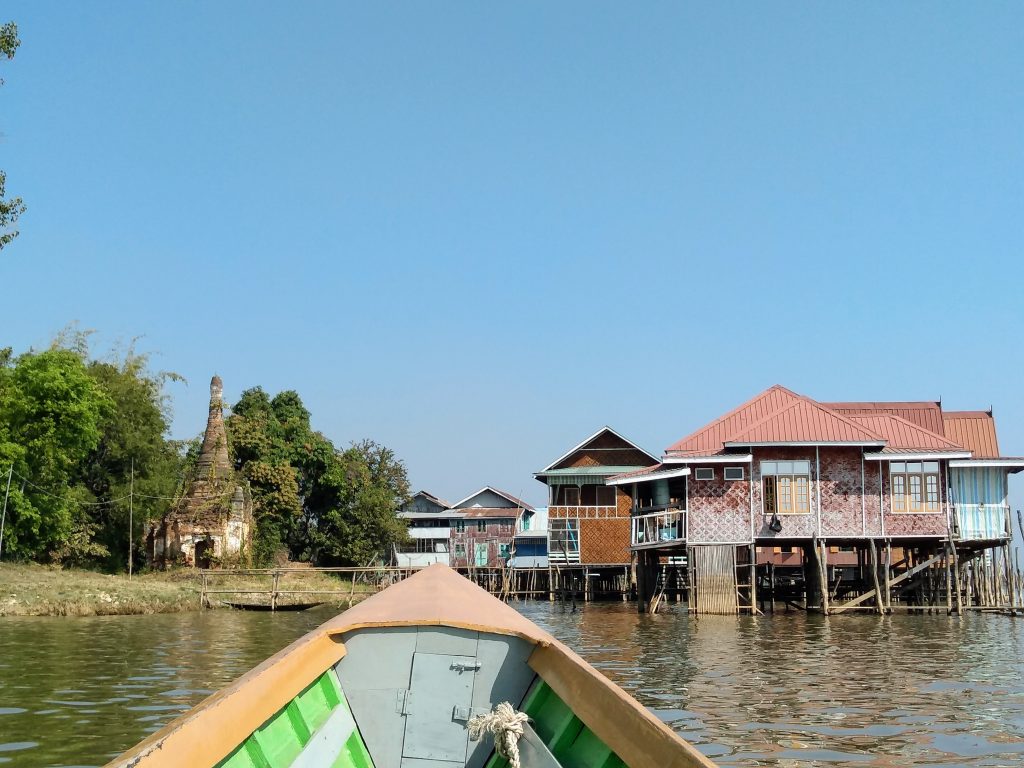
Well, 4 ladies sitting on the floor, rolling cigars and cheroots. The latter, being made in a variety of flavours. The dried thanat leaves rolled around various proportions of crushed tobacco, dried wood, and the flavouring. One end was pinched closed for lighting, the other end containing a filter of dried corn husks wrapped in paper.
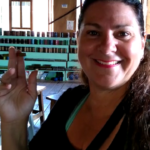
Tania wanted to try one so she opted for banana flavour. 🍌🍌🍌
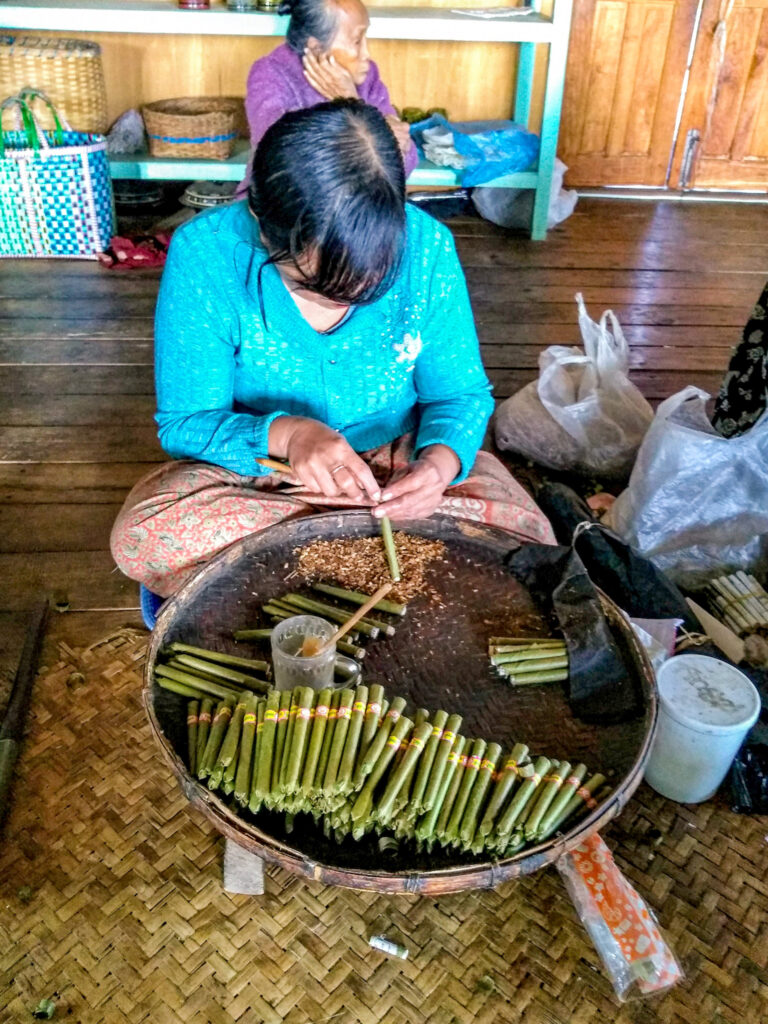
The boat building workshop was the next port of call. It is here that the large teak tree trunks are hand-sawn into planks before being planned smooth and affixed to the timber stutts.
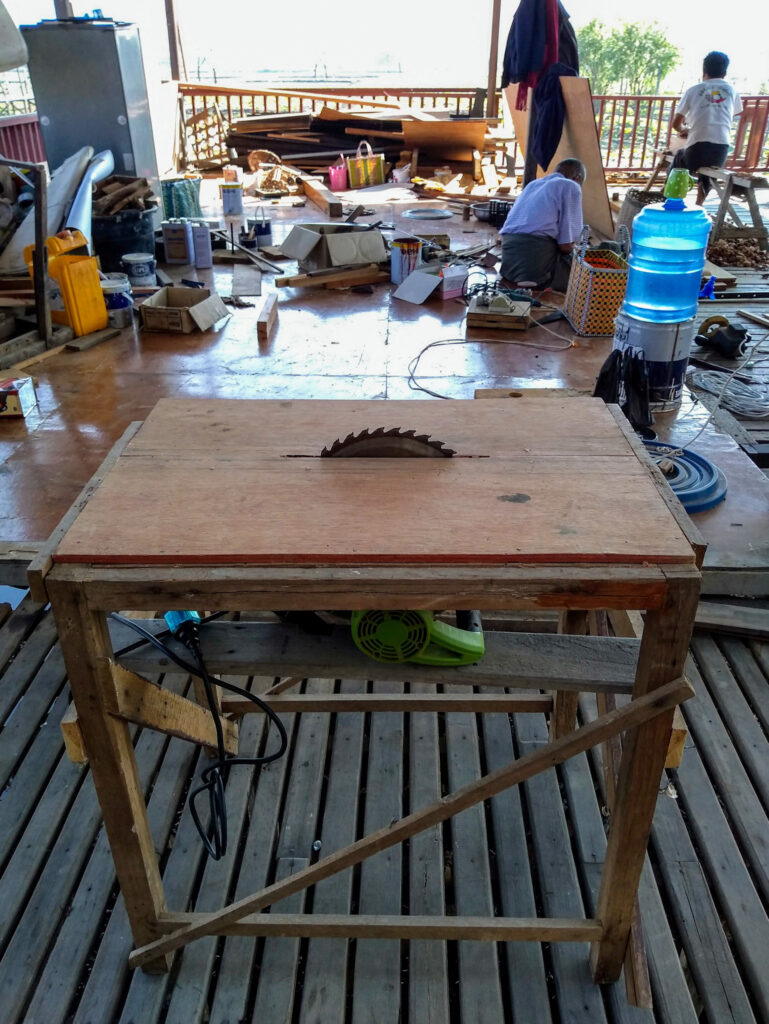
No electric or cordless drills here. All holes were made with a brace and bit. Screws tightened in a similar fashion with another brace. The sawdust is gathered and added to tar like substance together with flour, which was then painted onto the teak for waterproofing purposes.


The final craft industry we visited in the village was silversmithing. The silver is brought in from the mines that line the hills surrounding the lake. It is smelted and silver ingots produced. These are then rolled flat or drawn into silver wire before being made into various items of silver jewellery.
Phaung Daw Oo Pagoda
The major sanctuary of the lake, which features 5 sacred Buddha images. These have been covered in gold leaf to the point that their original forms cannot be seen. The monastery is open to all for veneration, but only men are permitted to place gold leaf on the images.
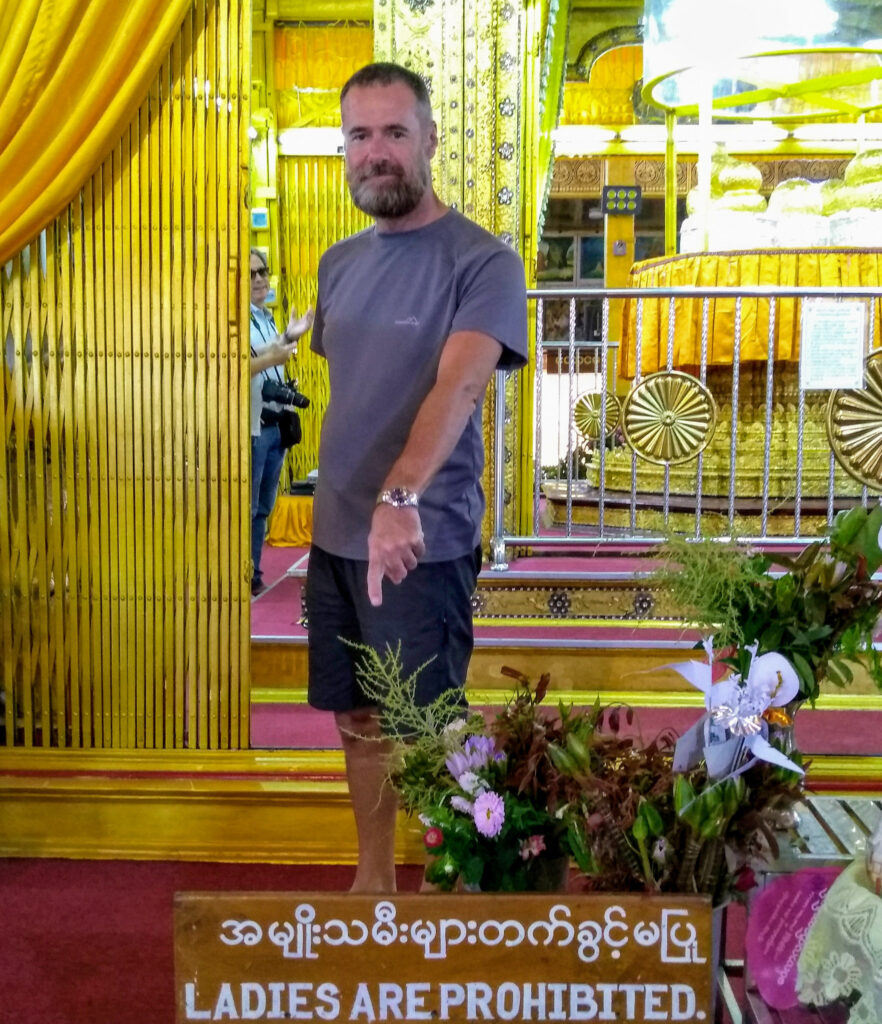
During the Burmese month of Thadingyut ( September to October), there is an 18-day pagoda festival. Four of the Buddha images are taken around Inle Lake on a replica royal barge designed as a hintha bird. One image always remains at the temple.
The elaborately decorated barge is towed by several boats of leg-rowers and other accompanying boats. The barge is towed from village to village around the lake in a clockwise direction. The four images reside at the main monastery in each village for the night.
Indein
Situated on the southwestern shore of the lake. Indein is a small village known for its market and two groups of ancient pagodas. Travelling down the small Inn Thein creek, through many bamboo river “gates” and under numerous bamboo footbridges leading to the village.


Around the village are two groups of ancient pagodas, Nyaung Ohak and Shwe Inn Thein.
Sited close to the boat mooring was Nyaung Ohak. A group of unrestored pagodas in various states of repair. Some are in a good condition, while others have plants and trees growing out of them. Many of the pagodas are decorated with sculptings of celestial beings and mythological animals.

From Nyaung Ohak a 700m covered walkway leads up to the Shwe Inn Thein Pagodas. Lined with stalls selling Shan shoulder bags, longyis, shirts and other items, the walkway gently climbs to the top of the hill to the site containing hundreds of pagodas. Most are from the 17th and 18th century, but the earliest one with an inscription dates from the 14th century.

Padaung tribe craft centre
Our penultimate stop was at a craft center. Although not indigenous to the Inle Lake area, 3 ladies from the Padaung tribe reside here.

The women of this tribe are better known for wearing long brass neck rings. It is thought that the rings might have protected women from becoming slaves by making them less attractive to other tribes.

It has been suggested that the coils make them resemble a dragon, an important figure in Kayan folklore. Lastly, they are worn as a means to protect from tiger bites, as attacking tigers aim for the neck. Whatever the reason, they don’t look very comfortable.

Nga Phe Chaung Monastery
Our last stop of the day was at the Nga Phe Chaung Monastery. A beautiful wooden monastery built on stilts around 200 years ago. Locally known as Jumping Cat Monastery, the cats were trained to jump through hoops as a tourist attraction.

After the death of the head monk, his predecessor didn’t think it appropriate for monks to train cats to perform tricks for tourists. The only cats there now have a quiet and peaceful lifestyle. Except for all the tourists coming to see them of course!
Unfortunately, our tour had come to its end. Racing back across the lake in our fun indigenous mode of transport we were dropped off at our accommodation at 1610 hrs. What a wonderful day out.
The Red Mountain Estate vineyard
The following day we chose to visit The Red Mountain Estate vineyard for a wine tasting.

The Estate is about 3 miles outside of the town. To get there, we hired city pushbikes at 1500 Kyat each for the whole day.

The leisurely ride took us about 35 minutes to get to the entrance of the Estate. The winery has a bike parking shelter at the bottom of the hill. We chose to leave our bikes here and walk up rather than try to cycle up.

The walk up took less than 10 minutes. Once at the top, we were greeted warmly by the staff who directed us to where we could partake in wine tasting.

The tasting cost 5000 Kyat per person. We got to taste 4 of the Estates wines and a small plate of peanuts. It was a very pleasant experience taking some time to walk around the winery and the vineyards. Prior to leaving we enjoyed a tasty snack in the on site restaurant before cycling back to our accommodation.





